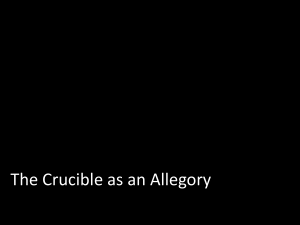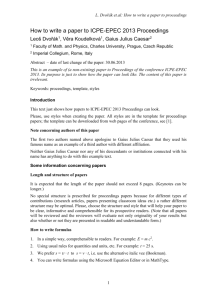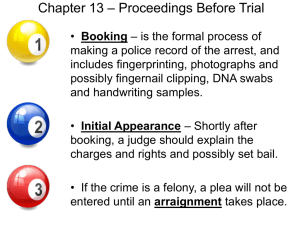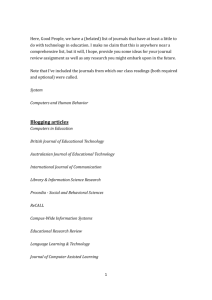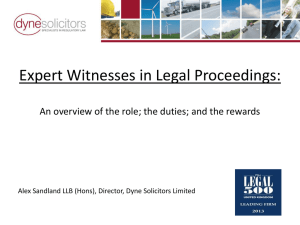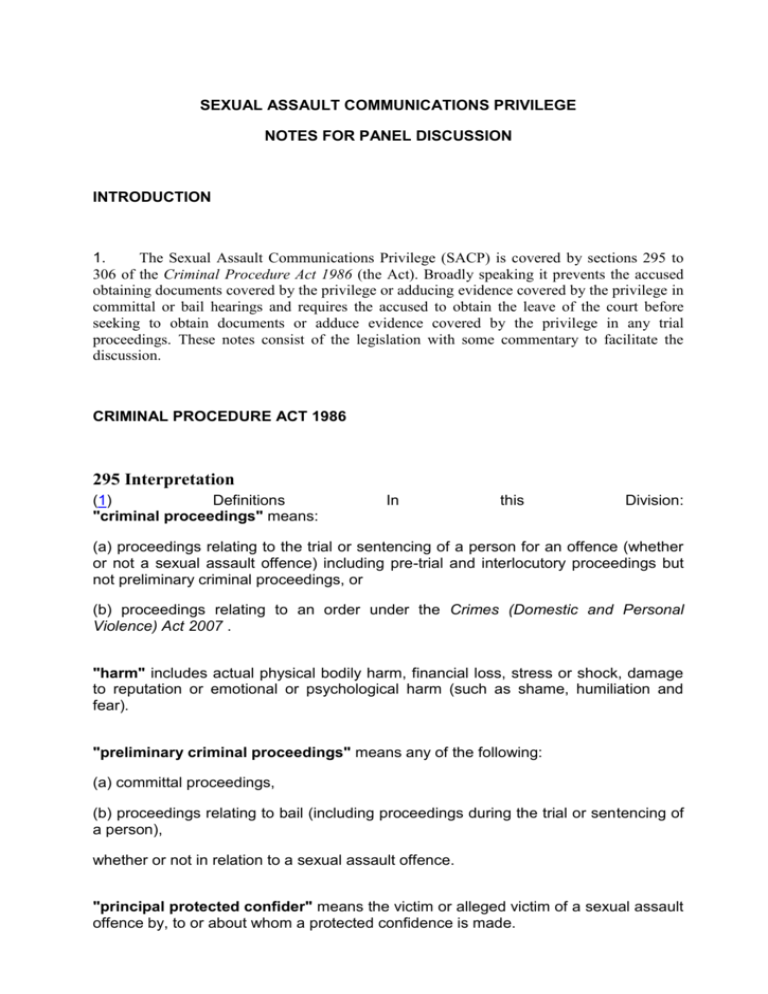
SEXUAL ASSAULT COMMUNICATIONS PRIVILEGE
NOTES FOR PANEL DISCUSSION
INTRODUCTION
1.
The Sexual Assault Communications Privilege (SACP) is covered by sections 295 to
306 of the Criminal Procedure Act 1986 (the Act). Broadly speaking it prevents the accused
obtaining documents covered by the privilege or adducing evidence covered by the privilege in
committal or bail hearings and requires the accused to obtain the leave of the court before
seeking to obtain documents or adduce evidence covered by the privilege in any trial
proceedings. These notes consist of the legislation with some commentary to facilitate the
discussion.
CRIMINAL PROCEDURE ACT 1986
295 Interpretation
(1)
Definitions
"criminal proceedings" means:
In
this
Division:
(a) proceedings relating to the trial or sentencing of a person for an offence (whether
or not a sexual assault offence) including pre-trial and interlocutory proceedings but
not preliminary criminal proceedings, or
(b) proceedings relating to an order under the Crimes (Domestic and Personal
Violence) Act 2007 .
"harm" includes actual physical bodily harm, financial loss, stress or shock, damage
to reputation or emotional or psychological harm (such as shame, humiliation and
fear).
"preliminary criminal proceedings" means any of the following:
(a) committal proceedings,
(b) proceedings relating to bail (including proceedings during the trial or sentencing of
a person),
whether or not in relation to a sexual assault offence.
"principal protected confider" means the victim or alleged victim of a sexual assault
offence by, to or about whom a protected confidence is made.
"protected confidence" —see section 296.
"protected confider" , in relation to a protected confidence, means:
(a) the principal protected confider, or
(b) any other person who made the protected confidence.
"sexual assault offence" means:
(a) a prescribed sexual offence, or
(a1) acts that would constitute a prescribed sexual offence if those acts:
(i) had occurred in this State, or
(ii) had occurred at some later date, or
(iii) had both occurred in this State and occurred at some later date, or
(b) any other offence prescribed by the regulations for the purposes of this definition.
(2) Document recording a protected confidence In this Division, a reference to a
document recording a protected confidence:
(a) is a reference to any part of the document that records a protected confidence or
any report, observation, opinion, advice, recommendation or other matter that relates
to the protected confidence made by a protected confider, and
(b) includes a reference to any copy, reproduction or duplicate of that part of the
document.
(3) Electronic documents For the purposes of this Division, if a document recording a
protected confidence is stored electronically and a written document recording the
protected confidence could be created by use of equipment that is usually available
for retrieving or collating such stored information, the document stored electronically is
to be dealt with as if it were a written document so created.
What is a protected confidence?
296 What is a protected confidence?
(1)
In
this
Division:
"protected confidence" means a counselling communication that is made by, to or
about a victim or alleged victim of a sexual assault offence.
(2) A counselling communication is a protected confidence for the purposes of this
Division even if it:
2
(a) was made before the acts constituting the relevant sexual assault offence occurred
or are alleged to have occurred, or
(b) was not made in connection with a sexual assault offence or alleged sexual
assault offence or any condition arising from a sexual assault offence or alleged
sexual assault offence.
(3) For the purposes of this section, a communication may be made in confidence
even if it is made in the presence of a third party if the third party is present to facilitate
communication or to otherwise further the counselling process.
(4)
In
this
"counselling communication" means a communication:
section:
(a) made in confidence by a person (the "counselled person") to another person (the
"counsellor") who is counselling the person in relation to any harm the person may
have suffered, or
(b) made in confidence to or about the counselled person by the counsellor in the
course of that counselling, or
(c) made in confidence about the counselled person by a counsellor or a parent, carer
or other supportive person who is present to facilitate communication between the
counselled person and the counsellor or to otherwise further the counselling process,
or
(d) made in confidence by or to the counsellor, by or to another counsellor or by or to
a person who is counselling, or has at any time counselled, the person.
(5) For the purposes of this section, a person "counsels" another person if:
(a) the person has undertaken training or study or has experience that is relevant to
the process of counselling persons who have suffered harm, and
(b) the person:
(i) listens to and gives verbal or other support or encouragement to the other person,
or
(ii) advises, gives therapy to or treats the other person,
whether or not for fee or reward.
297 Protected confidences—preliminary criminal proceedings
(1) A person cannot seek to compel (whether by subpoena or any other procedure)
any other person to produce a document recording a protected confidence in, or in
connection with, any preliminary criminal proceedings.
(2) A document recording a protected confidence cannot be produced in, or in
connection with, any preliminary criminal proceedings.
3
(3) Evidence cannot be adduced in any preliminary criminal proceedings if it would
disclose a protected confidence or the contents of a document recording a protected
confidence.
298 Protected confidences—criminal proceedings
(1) Except with the leave of the court, a person cannot seek to compel (whether by
subpoena or any other procedure) any other person to produce a document recording
a protected confidence in, or in connection with, any criminal proceedings.
(2) Except with the leave of the court, a document recording a protected confidence
cannot be produced in, or in connection with, any criminal proceedings.
(3) Except with the leave of the court, evidence cannot be adduced in any criminal
proceedings if it would disclose a protected confidence or the contents of a document
recording a protected confidence.
305A Subpoenas for production of counselling communications
The regulations may make provision for or with respect to the issue and service of
subpoenas requiring the production of a document recording a counselling
communication (within the meaning of section 296) in, or in connection with, any
criminal proceedings or preliminary criminal proceedings, including the following:
(a) the manner and time in which a subpoena must be served,
(b) the form of a subpoena,
(c) any documents or information that must be included with a subpoena.
As far as I am aware no regulations have been enacted pursuant to this section to date.
Accordingly I advise solicitors to file a notice of motion seeking leave to issue a subpoena to
the person or organisation in question. The affidavit in support of the motion by the solicitor
with carriage of the matter should annexe the proposed subpoena. All of this material should
then be forwarded to the DPP in the form of a notice pursuant to s 299C of the Act.
299 Court to inform of rights under Division
If it appears to a court that a witness, party or protected confider may have grounds
for making an application under this Division or objecting to the production of a
document or the adducing of evidence, the court must satisfy itself (or if there is a jury,
in the absence of the jury) that the person is aware of the relevant provisions of this
Division and has been given a reasonable opportunity to seek legal advice.
4
299A Protected confider has standing
A protected confider who is not a party may appear in criminal proceedings or
preliminary criminal proceedings if a document is sought to be produced or evidence
is sought to be adduced that may disclose a protected confidence made by, to or
about the protected confider.
299B Determining if there is a protected confidence
(1) If a question arises under this Division relating to a document or evidence, a court
may consider the document or evidence.
(2) If there is a jury, the document or evidence is to be considered in the absence of
the jury.
(3) A court must not make available or disclose to a party (other than a protected
confider) any document or evidence to which this section applies (or the contents of
any such document) unless:
(a) the court determines that the document does not record a protected confidence or
that the evidence would not disclose a protected confidence, or
(b) a party has been given leave under this Division in relation to the document or
evidence and making available or disclosing the document or evidence is consistent
with that leave.
(4) A court may make any orders it thinks fit to facilitate its consideration of a
document or evidence under this section.
(5) This section has effect despite sections 297 and 298.
This section applies where the document or evidence subject to the claim for privilege has
already been produced to the court. If this production has been in answer to a subpoena issued
with the leave of the court then the accused would seek access to the document or evidence
pursuant to ss (3) (b).
If the document or evidence has been produced in answer to a subpoena which has been issued
without the leave of the court then typically access will be denied and orders made for the
Complainant to obtain legal representation and thereafter instruct whether they wish to claim
the SACP or consent to the parties having access to the documents or evidence.
If there is an appearance by the Complainant’s legal representative they may submit that the
subpoena is invalid pursuant to s 298 of the Act and that the documents or evidence should be
returned to the party producing it. The accused should seek the leave of the Court to re-issue
the subpoena returnable instanter to cure this defect and waive the notice provisions given that
the Complainant is already represented and the documents have already been produced.
5
The Complainant’s legal representative may challenge the subpoena on the grounds that it
lacks a legitimate forensic purpose and submit that access to the documents or evidence
produced should be denied independently of the SACP. The relevant test was confirmed in AG for NSW v Chidgey [2008] NSWCCA 65 at [64] as that stated by Simpson J (Spigelman CJ
Studdert J agreeing) in R v Saleam [1999] NSWCCA 86 as follows:“11 The principles governing applications of this kind are no different from
those governing applications for access to documents produced in answer to a
subpoena. Before access is granted (or an order to produce made) the applicant must
(i) identify a legitimate forensic purpose for which access is sought; and (ii) establish
that it is “on the cards” that the documents will materially assist his case. So much
was established in earlier proceedings brought by this applicant: R v Saleam (1989)
16 NSWLR 14, per Hunt CJ at CL; see also R v Ali Tastan (1994) 75 A Crim R 498
per Barr AJ, as he then was.”
It is suggested that the accused will establish a legitimate forensic purpose by identifying the
reason for the subpoena ie by identifying the documents or evidence that you anticipate have
been or will be produced and by indicating how such documents or evidence will assist your
case. On the application of this test some assistance can be obtained from the observations of
Hunt J (Carruthers and Grove JJ agreeing) in R v Saleam (1989) 16 NSWLR 14 at 18 as
follows:“In my view, when a trial judge is faced with a subpoena of this kind, he should
require counsel for the accused to identify expressly and with precision the legitimate
forensic purpose for which he seeks access to the documents, and the judge should
refuse access to the documents until such an identification has been made.
Sometimes that purpose will not become apparent (even to the accused who had
advised the issue of the subpoena) until the trial has been underway for some time (cf
Waind v Hill [1978] 1 NSWLR 372 at 385), and the judge’s initial refusal to permit
inspection is always open to review.”
Further on at page 19 his Honour observed: “On the other hand, nor should I be
understood by what I have said so far as encouraging Crown Prosecutors to take
blanket objections to every document of which production is sought on the ground that
no legitimate forensic purpose is served by its production….. As Samuels JA
suggested (in Maddison v Goldrick [1976] 1 NSWLR 651 at 667-8) an accused is
prime facie entitled to inspect any document which might give him the opportunity to
pursue a proper and fruitful course in cross-examination.”
299C Notice of application for leave
(1) An applicant for leave under this Division must, as soon as is reasonably
practicable, give notice in writing of the application to each other party and each
relevant protected confider (or the protected confider’s nominee) that:
(a) specifies the document that is sought to be produced or the evidence that is
sought to be adduced, and
(b) in the case of a notice to a protected confider who is not a party to the
proceedings—advises the protected confider that the protected confider may appear
in the proceedings concerned, and
6
(c) in the case of an application for leave to compel (whether by subpoena or any
other procedure) a person to produce a document—specifies the day on which the
document is to be produced, and
(d) in the case of an application for leave to adduce evidence—specifies the day (if
known) when the proceedings are to be heard, and
(e) includes any other matter that may be prescribed by the regulations.
(2) A requirement to give notice to a protected confider who is not a party to
proceedings is satisfied for the purposes of this section if the notice is given to:
(a) the prosecutor in the criminal proceedings, or
(b) if the regulations prescribe a different person or body, that person or body.
(3) A prosecutor (or person or body) who is given a copy of a notice under subsection
(2) must ensure that a copy of the notice is given to the protected confider within a
reasonable time after its receipt.
(4) A court cannot grant an application for leave under this Division until at least 14
days (or such shorter period as may be fixed by the court) after the relevant notices
have been given under subsection (1) or (2).
(5) A court may waive the requirement to give notice if:
(a) notice has already been given in respect of an application under this Division,
being an application that relates to the same protected confidence and the same
criminal proceedings, or
(b) the principal protected confider has consented in writing to the notice being
waived, or
(c) the court is satisfied that there are exceptional circumstances that require the
notice to be waived.
(6) The regulations may make provision for or with respect to the giving of notices
under this section.
299D Determining whether to grant leave
(1) The court cannot grant an application for leave under this Division unless the court
is satisfied that:
(a) the document or evidence will, either by itself or having regard to other documents
or evidence produced or adduced or to be produced or adduced by the party seeking
to produce or adduce the document or evidence, have substantial probative value,
and
(b) other documents or evidence concerning the matters to which the protected
confidence relates are not available, and
7
(c) the public interest in preserving the confidentiality of protected confidences and
protecting the principal protected confider from harm is substantially outweighed by
the public interest in admitting into evidence information or the contents of a document
of substantial probative value.
(2) Without limiting the matters that the court may take into account for the purposes
of determining the public interest in preserving the confidentiality of protected
confidences and protecting the principal protected confider from harm, the court must
take into account the following:
(a) the need to encourage victims of sexual offences to seek counselling,
(b) that the effectiveness of counselling is likely to be dependent on the maintenance
of the confidentiality of the counselling relationship,
(c) the public interest in ensuring that victims of sexual offences receive effective
counselling,
(d) that the disclosure of the protected confidence is likely to damage or undermine
the relationship between the counsellor and the counselled person,
(e) whether disclosure of the protected confidence is sought on the basis of a
discriminatory belief or bias,
(f) that the adducing of the evidence is likely to infringe a reasonable expectation of
privacy.
(3) For the purposes of determining an application for leave under this Division, the
court may permit a confidential statement to be made to it by or on behalf of the
principal protected confider by affidavit specifying the harm the confider is likely to
suffer if the application for leave is granted.
(4) A court must not disclose or make available to a party (other than the principal
protected confider) any confidential statement made to the court under this section by
or on behalf of the principal protected confider.
(5) The court must state its reasons for granting or refusing to grant an application for
leave under this Division.
(6) If there is a jury, the court is to hear and determine any application for leave under
this Division in the absence of the jury.
Pursuant to ss (1) (a) the applicant for leave needs to establish that the document or evidence
will have substantial probative value in the trial. Substantial probative value is not defined in
this Division of the Act but is a familiar concept in criminal trials particularly re the
application of other provisions of the Act such as s 293 and of the Evidence Act 1995 and it is
submitted that the meaning to be given to the words in this context can be gleaned from the
many authorities dealing with these words in those other contexts.
Probative value is defined in the Dictionary to the Evidence Act as follows: "probative
value" of evidence means the extent to which the evidence could rationally affect the
assessment of the probability of the existence of a fact in issue.
8
“Substantial” has been held to refer to a greater degree of relevance than “significant” see R v
Lockyer (1996) 89 A Crim R 457; AW v The Queen [2009] NSWCCA 1 at [47]; R v Fletcher
[2005] NSWCCA 338; (2005) 156 A Crim R 308 at [33]; and R v Zhang [2005] NSWCCA
437; (2005) A Crim R 504 at [139].
S 103 of the Evidence Act 1995 provides an exception to the credibility rule permitting crossexamination of a witness “if the evidence could substantially affect the assessment of the
credibility of the witness”. The previous version of the s 103 required that the evidence be of
“substantial probative value” and that phrase was analysed by the CCA in R v El-Azzi [2004]
NSWCCA 455 as follows:“179 The first question for determination was the question raised by s103(1): did the
evidence have “substantial probative value”? That raises a further question:
“substantial probative value” of what?
180 “Probative value” is defined in the Dictionary to the Evidence Act as:
“... the extent to which the evidence could rationally affect the assessment of the
probability of the existence of a fact in issue.”
181 That definition, however, does not apply to the use of the term “(substantial)
probative value” as it is used in s103(1). In R v RPS, unreported, NSWCCA, 13
August 1997, Hunt CJ at CL, with whom Gleeson CJ and Hidden J agreed, said:
“Section 103 of the Evidence Act limits cross-examination as to credit to adducing
evidence which has ‘substantial probative value’. The ‘probative value’ of evidence is
defined in the s3 Dictionary as meaning ‘the extent to which the evidence could
rationally affect the assessment of the probability of the existence of a fact in issue’,
but both the context in which that phrase appears and the subject matter of s103
indicate that that definition does not apply. That is made clear by the terms of subs(2),
which demonstrate that the evidence must have probative value in relation to the
credit of the witness. Evidence adduced in cross-examination must therefore
have substantial probative value in the sense that it could rationally affect the
assessment of the credit of the witness. Such an interpretation accords with the
intention of the Law Reform Commission. The addition of the word ‘substantial’
nevertheless imposes a limitation upon the common law, when almost anything was
allowed upon the issue of credit unless it clearly had no material weight whatsoever
upon that issue. That limitation is an important one.” (‘not’ in the second sentence is
italicised in the original; the emphasis placed on the fourth sentence is added; internal
references omitted)
182 That view of the meaning of the term was endorsed by the Full Court of the
Federal Court of Australia in Jacara Pty Ltd v Perpetual Trustees WA Ltd [2000]
FCA 1886; 106 FCR 51, per Sackville J, with whom Whitlam and Mansfield JJ agreed.
(RPS was the subject of a successful appeal to the High Court: RPS v The Queen
[2000] HCA 3; 199 CLR 620, but on matters unrelated to the present question.)
183 In my opinion, for this evidence to have had substantial probative value within the
meaning of s103(1), it must have had the potential to have a real bearing upon the
assessment of the appellant’s credibility – and, particularly, to the appellant’s
credibility in relation to the evidence he had given, or would give, at the trial. It cannot
have had substantial probative value for the purposes of s103(1) unless it was
capable, in a significant way, of bearing upon that assessment.”
9
It is submitted that given the nature of sexual assault trials where the prosecution typically
relies solely, or at least substantially, on the evidence of the Complainant and where the
reliability and credibility of the Complainant are disputed by the accused any document or
evidence which has the potential to have a real bearing upon the jury’s assessment of the
Complainant’s credibility in a significant or substantial way must have substantial probative
value. It is submitted that this is the appropriate meaning to be attributed to the words within
the context of this Division of the Act.
It will usually assist in this argument to highlight the directions that the accused will be
submitting that the trial judge make during the summing up (eg Murray, Markuleski,
Longman, s 165 Evidence Act 1995) to focus on the specific issues in the trial and how the
documents or evidence will have substantial probative value given the way the accused will be
conducting his case.
Re ss (1) (b) it will sometimes be submitted by the Complainant’s legal representative that
other documents or evidence concerning the type of matters contained in the documents or
evidence over which privilege is claimed are available therefore leave should be refused eg
with complaint evidence. For the accused any and all inconsistencies in the complaints made to
different witnesses are potentially of substantial probative value as they are relevant to the
jury’s assessment of the reliability of the Complainant. If there is a basis for anticipating that
the Complainant may have provided an inconsistent version of the alleged assault in a
counselling communication then the accused should press the application for access and refute
the submission that more than one version of the complaint are already available and a further
inconsistent complaint would not be of substantial probative value as a result.
Pursuant to ss (1) (c) the applicant needs to show that the public interest in admitting the
document or evidence substantially outweighs the public interest in preserving the protected
confidence or protecting the Complainant from harm. This is a balancing act and useful
guidance may be gathered from decisions concerning the operation of similar balancing acts
such as s 293 of the Act and s 121 – 126G of the Evidence Act 1995. For the accused this
exercise will usually come back to the assessment of the probative value of the documents or
evidence in the context of the trial and how denying access to the documents or evidence may
deny the accused a chance of acquittal. It is submitted that if the documents or evidence, either
alone or in conjunction with other evidence in the trial, are such that if the accused were not
given leave to access them or adduce them in evidence then he would lose the chance of an
acquittal, then the balancing exercise must be determined in his favour. On the other side of the
ledger if the documents or evidence cover the same areas as other evidence eg a further version
of complaint then it can be submitted that the public interest in preserving the protected
confidence or protecting the Complainant from harm is relatively low.
300 Effect of consent
(1) This Division does not prevent the production of any document recording a
protected confidence or the adducing of evidence disclosing a protected confidence or
the contents of a document recording a protected confidence, in, or in connection with,
any proceedings, if the principal protected confider to whom the proceedings relate
has consented to the production of the document or adducing of the evidence.
(2) Consent is not effective for the purposes of this section unless:
(a) the consent is given in writing, and
10
(b) the consent expressly relates to the production of a document or adducing of
evidence that is privileged under this Division or would be so privileged except for a
limitation or restriction imposed by this Division.
301 Loss of sexual assault communications privilege: misconduct
(1) This Division does not prevent the adducing of evidence of a communication
made, or the production or adducing of a document prepared, in the furtherance of the
commission of a fraud or an offence or the commission of an act that renders a person
liable to a civil penalty.
(2) For the purposes of this section, if the commission of the fraud, offence or act is a
fact in issue and there are reasonable grounds for finding that:
(a) the fraud, offence or act was committed, and
(b) a communication was made or document prepared in furtherance of the
commission of the fraud, offence or act,
the court may find that the communication was so made or document so prepared.
302 Ancillary orders
(1) Without limiting any action the court may take to limit the possible harm, or extent
of the harm, likely to be caused by the disclosure of evidence of, or the contents of a
document recording, a protected confidence, the court may:
(a) order that all or part of the evidence be heard or document produced in camera,
and
(b) make such orders relating to the production and inspection of the document as, in
the opinion of the court, are necessary to protect the safety and welfare of any
protected confider.
(c), (d) (Repealed)
(2) Nothing in this section limits the power of a court to make an order under section
106 or 119 of this Act or section 578A of the Crimes Act 1900 .
(3) (Repealed)
305 Inadmissibility of evidence
Evidence that, because of this Division, cannot be adduced or given in proceedings is
not admissible in the proceedings.
11
306 Application of common law
(1) This Division does not affect the operation of a principle or rule of the common law
in relation to evidence in criminal proceedings, except so far as this Division provides
otherwise expressly or by necessary intendment.
(2) Without limiting subsection (1), this Division does not affect the operation of such a
principle or rule so far as it relates to the inspection of a document required to be
produced in, or in connection with, criminal proceedings.
Jason Watts
30 July 2012
12


